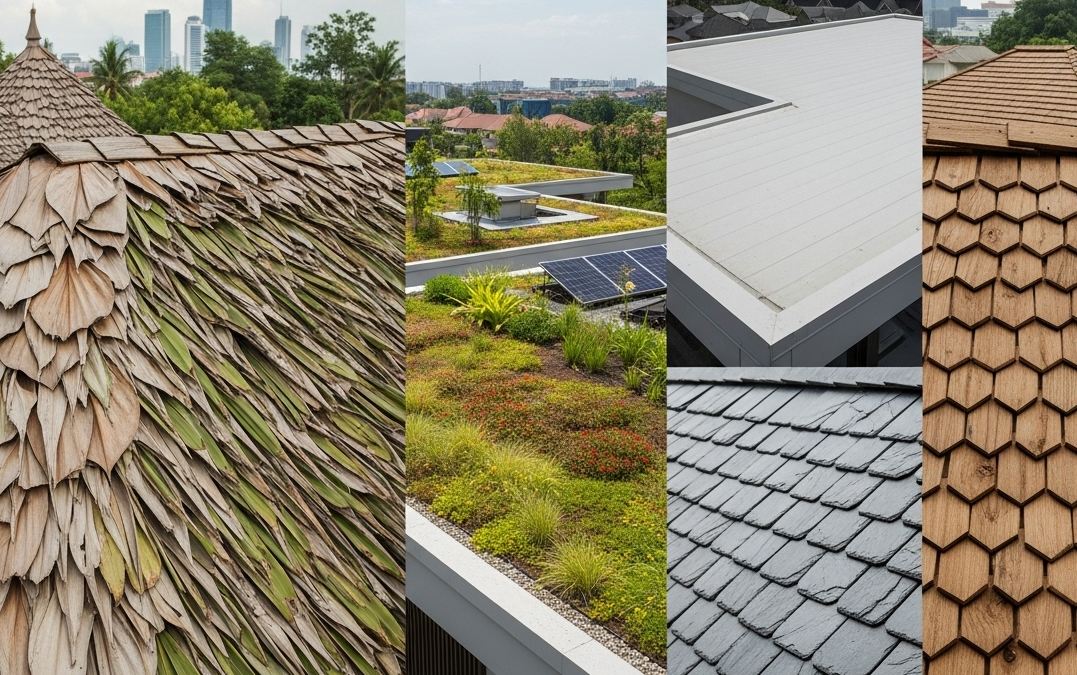Introduction
While clay tiles, concrete tiles, and metal sheets dominate Malaysia’s roofing market, there’s a rising interest in uncommon materials and innovative trends to meet modern demands for sustainability, aesthetics, and enhanced performance. This article explores these alternative roofing options and emerging architectural ideas shaping Malaysia’s roofing landscape beyond the mainstream.
Uncommon Roofing Materials in Malaysia
Nipah Palm Roofing (Atap Nipah)
A traditional roofing material made from the leaves of the Nipah palm, Atap Nipah provides a distinctive rustic appeal. Although it is infrequently used in contemporary construction, it offers natural insulation and is highly environmentally friendly, serving as a significant cultural connection to traditional Malay architecture. Its application is primarily confined to specific architectural or conservation projects that prioritize natural materials.
Green Roofs
Green roofs are increasingly recognized for their environmental advantages, such as mitigating urban heat island effects, improving stormwater management, and offering insulation. However, they remain relatively rare in Malaysian residential developments. The primary challenges include high installation and maintenance expenses, limited public awareness, and spatial limitations, particularly in terrace houses.
Polyurethane PU Roofing
PU roofing represents a modern material choice that emphasizes heat and sound insulation. Although it is more technical and less commonly used than traditional metal or tile roofs, PU roofing attracts those who desire exceptional thermal performance and noise reduction, in line with the growing demand for energy-efficient homes.
Slate Roofing
Renowned for its durability and visual appeal, natural slate roofing is a rare yet sophisticated option. Its elevated cost and substantial weight restrict its application mainly to luxury or heritage projects rather than widespread residential construction.
Wood Shingles (Belian Wood)
Wood shingles crafted from Belian wood (Borneo ironwood) are recognized for their natural appearance and durability. They are more commonly found in resorts and specialized projects that aim for an exotic or nature-integrated aesthetic, and are not typically utilized in standard Malaysian residential or commercial roofing.
Emerging Trends and Architectural Ideas
Solar Roofing
The integration of renewable energy is fueling the rise of solar roofing systems, which seamlessly incorporate photovoltaic panels or tiles into roofing designs. This trend is gaining momentum alongside Malaysia’s expanding renewable energy initiatives and objectives to enhance sustainability in construction.
Smart Roofing
While still in its early stages, smart roofing technologies that feature sensors for real-time leak detection and monitoring of roof conditions are beginning to emerge. This innovation offers the promise of improved maintenance and extended lifespans for roofs.
Contemporary Minimalism
Current Malaysian architecture tends to favor minimalist roof designs characterized by sleek profiles, including flat roofs, concealed gutters, and straightforward geometric shapes. This trend signifies a shift away from traditional pitched roofs towards more energy-efficient and visually streamlined building envelopes.
Re-adapting Traditional Designs
Certain architects are revisiting elements of traditional Malay houses—especially the high-pitched roofs—not solely for their aesthetic appeal but to utilize passive cooling through natural ventilation, thereby promoting low-energy, climate-responsive buildings that have yet to achieve mainstream acceptance.
Building Regulations and Challenges in Using Uncommon Materials
- The Uniform Building By-Laws of 1984 establish standards for roofing materials, taking into account structural load requirements in light of Malaysia’s severe rain and wind conditions.
- The Construction Industry Development Board (CIDB) is responsible for ensuring the quality of building materials, which requires adherence to regulations for alternative roofing products.
- Certain roofing systems, such as standard clay or concrete tiles, face limitations when used on low-pitched roofs, thus making metal tiles a more appealing option for specific architectural designs.
- While there is no complete prohibition on most alternative roofing options (with the exception of partial asbestos restrictions), regulatory compliance may hinder their widespread adoption.
- The increasing emphasis on sustainability, coupled with market demands for durability, thermal efficiency, and innovative aesthetics, will likely sustain interest in unconventional roofing materials.
Conclusion
While clay tiles, concrete tiles, and metal roofing are prevalent in Malaysia’s market due to their affordability, durability, and suitability for the climate, a developing niche segment is investigating unconventional materials and designs. Motivated by sustainability, aesthetics, and thermal efficiency, options such as Atap Nipah, green roofs, PU roofing, slate, and Belian wood shingles present intriguing alternatives. Current trends encompass solar and smart roofing technologies, minimalist designs, and modern interpretations of traditional styles. Although regulatory standards and market obstacles persist, innovation in roofing is progressively transforming Malaysia’s architectural landscape towards more sustainable, intelligent, and visually varied built environments.

